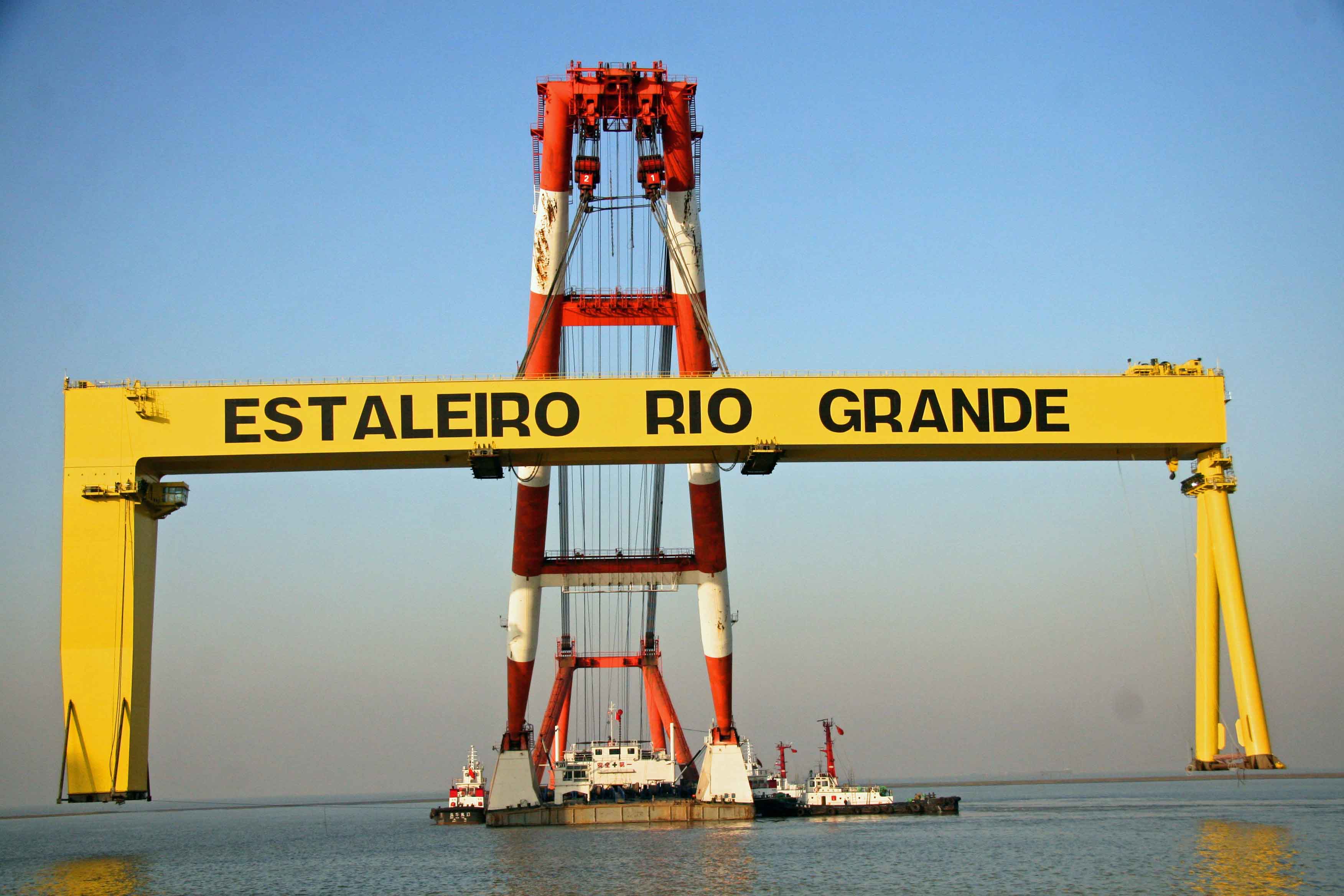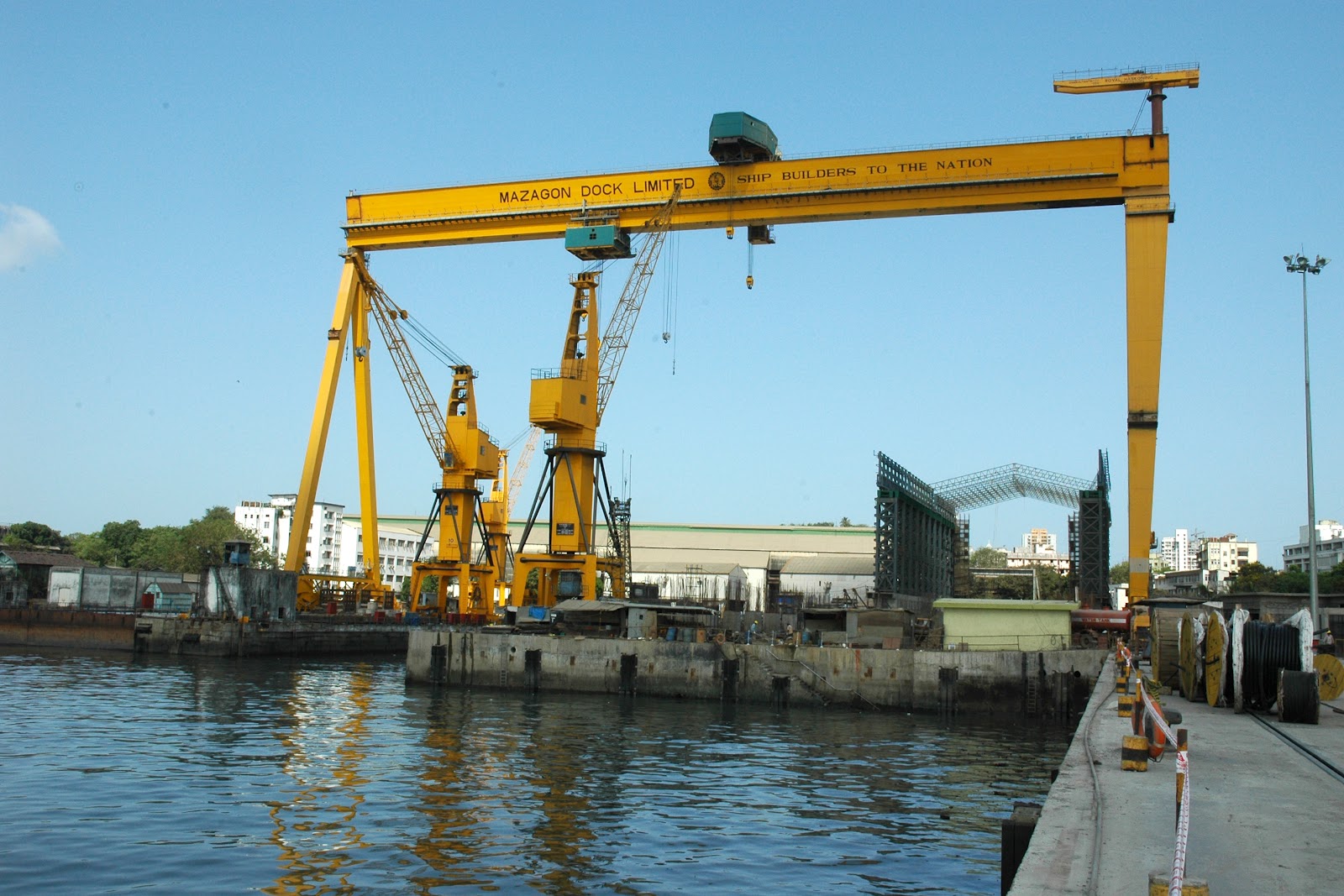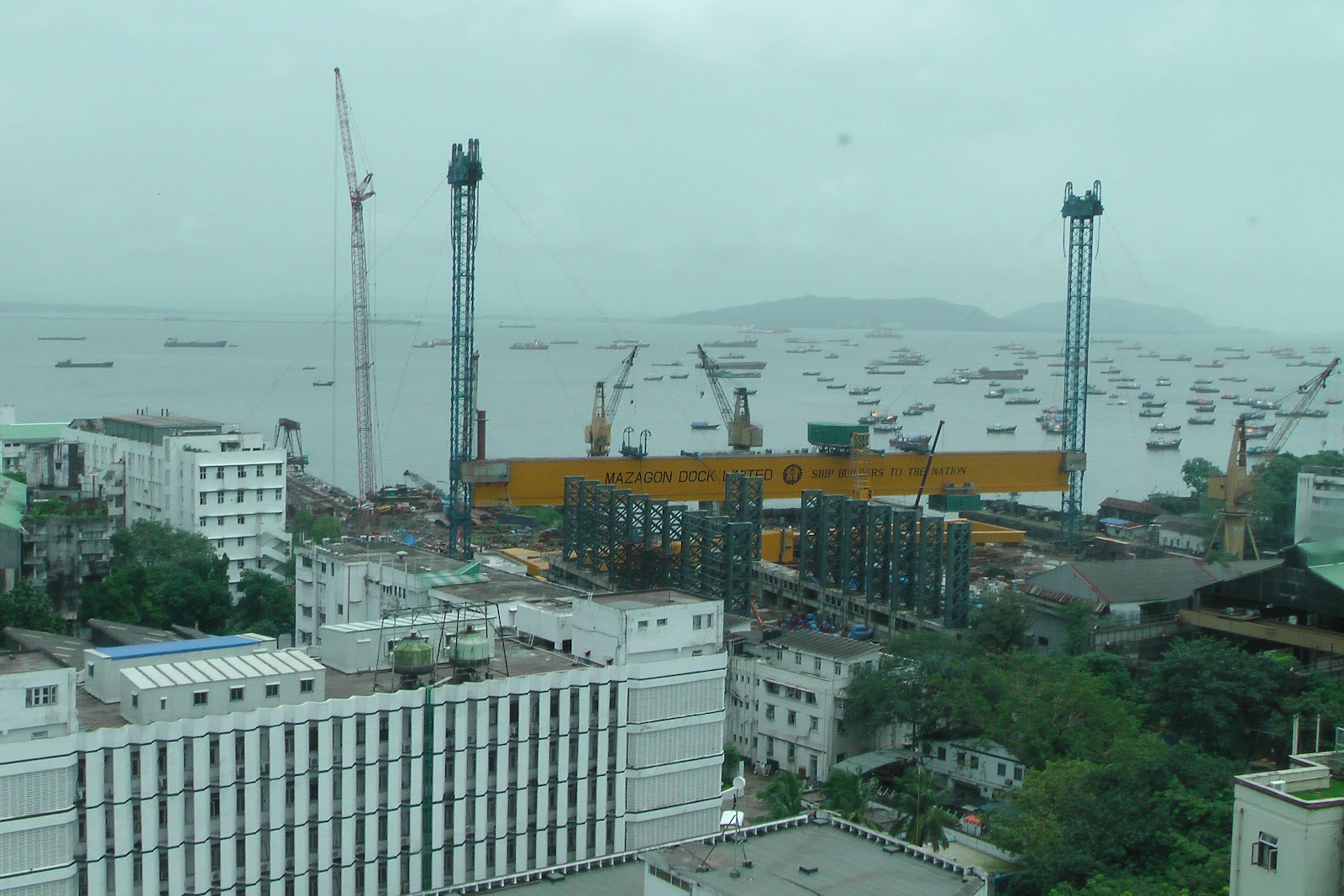IND151
BANNED

- Joined
- Oct 25, 2010
- Messages
- 10,170
- Reaction score
- 3
- Country
- Location
A humming construction site in Mumbai’s Mazagon Dock Ltd (MDL) holds the promise of a new era in warship building in India. Everything about this emerging new shipyard is enormous: the 200-metre-long workshop; a Goliath crane that dwarfs everything around; and an expansive “wet basin”, which is an enclosed harbour that will comfortably house two large warships.
This is MDL’s new Rs 826 crore “modular” shipyard that is expected to slash down the time taken to build warships for the Indian Navy. Defence shipyards currently take over ten years to build major warships like destroyers, frigates and corvettes. When the new yard is commissioned in June 2013, frigates will be built in 60 months; destroyers will take 72 months.
Building warships faster is crucial for the navy. Its Maritime Capability Perspective Plan (MCPP) of 2005 envisions a 160-ship navy, with 90 capital warships like aircraft carriers, destroyers, frigates and corvettes. Today, however, the navy has just 134 ships, with less than half the destroyers and frigates it needs. Bridging this gap of 26 ships, while also replacing warships that are being decommissioned after completing their 30-40 year service lives, requires a major boost in indigenous build capability.
To achieve this, MDL --- along with the other big defence shipyard, Garden Reach Shipbuilders & Engineers, Kolkata (GRSE) --- is abandoning traditional shipbuilding. That involves welding a hull together and launching it into water, after which swarms of craftsmen painstakingly work in the warship’s cramped compartments, installing propulsion gear, electrically equipment, weapons, sensors and hundreds of kilometres of pipes and wiring. This is a slow process.
Instead, construction will now be like a giant Lego game: convenient 300-ton blocks will be built separately, and then assembled together into a complete warship. Each block will be fabricated in a well-lit, ventilated workshop with multi-level access, and will be complete with all the piping, electrical wiring and fitments that run through a ship. Each block must dovetail precisely with its neighbouring block, every wire, pipe and compartment coming together in perfect alignment.
PK Bhattacharjee, General Manager of the Mazagon Modernisation Project (MMP), who is conducting Business Standard through an exclusive, pre-inauguration tour of the shipyard, explains what happens next. After a block is completed in the worker-friendly environment of the modular workshop, the workshop’s roof is retracted and the rail-mounted Goliath crane reaches in and lifts out the 300-tonne block. It then transports it to the slipway where it takes its place in the warship that is taking shape. After about 20 blocks come together, the 3000-tonne semi-built warship is launched into the water and towed to the “wet basin”, where the superstructure, and weapons and sensors are put in.
“The capability to lift 300 tonnes is what makes modular shipbuilding possible. For decades, we have worked with 40-tonne cranes,” explains Battacharjee.
The first warships that will emerge from this process are 7 frigates of Project 17A. MDL will build four frigates, while GRSE will build three. The Project 17A frigates will be outwardly similar to their predecessors, the three Shivalik-class frigates of Project 17, which MDL has just completed. But modular shipbuilding is expected to ensure that Project 17A is completed must faster.
Back in MDL’s corporate office the new chairman, Rear Admiral (Retired) Rahul Kumar Shrawat, explains that the technological challenge of modular shipbuilding lies in designing each 300-tonne block so that it is fully kitted and fits exactly into the next. Since this process is new to India, Fincantieri, an Italian shipbuilder, will provide consultancy for the new design process.
“MDL’s board, in coordination with our partner shipyard, GRSE, will decide on the design consultancy for Project 17A. It will be a shipyard’s decision. The navy has specified only that integrated (modular) construction must take place,” says Shrawat.
Dutch company, Royal Haskoning, has functioned as prime consultant for the MMP, which has taken five years. Haskoning has prepared the design, organised site surveys and geotechnical investigations and is now supervising construction. Hyderabad-based Nagarjuna Construction has done the civil works, including the 8000 square metre workshop with a retractable roof.
A key construction challenge has been the Goliath crane, a Rs 89 crore, 2200-tonne structure that traverses on rails and extends 138 metres across the yard. Designed by Konecrane of Finland, the Goliath crane was physically erected by Fagioli of Italy. Kolkata-based company, McNally Bharat, was the Indian contractor.
Most pleasing to MDL officials is the third element of the MMP: a new wet basin that offers 25,000 square metres of berthing space for under-construction warships. MDL has long functioned with just the 14,000 square metre Kasara Wet Basin, which was built in 1774 to service warships of the East India Company. But, with three projects simultaneously ongoing, MDL had to berth under-construction warships at the Naval Dockyard, several kilometres away, transporting labour, stores and machinery to the naval facility everyday.
From next month, the wet basin and the Goliath crane will start functioning. The rest of the workshop is scheduled to be inaugurated in June 2013.
Broadsword: New yards, techniques, to speed up warship building
This is MDL’s new Rs 826 crore “modular” shipyard that is expected to slash down the time taken to build warships for the Indian Navy. Defence shipyards currently take over ten years to build major warships like destroyers, frigates and corvettes. When the new yard is commissioned in June 2013, frigates will be built in 60 months; destroyers will take 72 months.
Building warships faster is crucial for the navy. Its Maritime Capability Perspective Plan (MCPP) of 2005 envisions a 160-ship navy, with 90 capital warships like aircraft carriers, destroyers, frigates and corvettes. Today, however, the navy has just 134 ships, with less than half the destroyers and frigates it needs. Bridging this gap of 26 ships, while also replacing warships that are being decommissioned after completing their 30-40 year service lives, requires a major boost in indigenous build capability.
To achieve this, MDL --- along with the other big defence shipyard, Garden Reach Shipbuilders & Engineers, Kolkata (GRSE) --- is abandoning traditional shipbuilding. That involves welding a hull together and launching it into water, after which swarms of craftsmen painstakingly work in the warship’s cramped compartments, installing propulsion gear, electrically equipment, weapons, sensors and hundreds of kilometres of pipes and wiring. This is a slow process.
Instead, construction will now be like a giant Lego game: convenient 300-ton blocks will be built separately, and then assembled together into a complete warship. Each block will be fabricated in a well-lit, ventilated workshop with multi-level access, and will be complete with all the piping, electrical wiring and fitments that run through a ship. Each block must dovetail precisely with its neighbouring block, every wire, pipe and compartment coming together in perfect alignment.
PK Bhattacharjee, General Manager of the Mazagon Modernisation Project (MMP), who is conducting Business Standard through an exclusive, pre-inauguration tour of the shipyard, explains what happens next. After a block is completed in the worker-friendly environment of the modular workshop, the workshop’s roof is retracted and the rail-mounted Goliath crane reaches in and lifts out the 300-tonne block. It then transports it to the slipway where it takes its place in the warship that is taking shape. After about 20 blocks come together, the 3000-tonne semi-built warship is launched into the water and towed to the “wet basin”, where the superstructure, and weapons and sensors are put in.
“The capability to lift 300 tonnes is what makes modular shipbuilding possible. For decades, we have worked with 40-tonne cranes,” explains Battacharjee.
The first warships that will emerge from this process are 7 frigates of Project 17A. MDL will build four frigates, while GRSE will build three. The Project 17A frigates will be outwardly similar to their predecessors, the three Shivalik-class frigates of Project 17, which MDL has just completed. But modular shipbuilding is expected to ensure that Project 17A is completed must faster.
Back in MDL’s corporate office the new chairman, Rear Admiral (Retired) Rahul Kumar Shrawat, explains that the technological challenge of modular shipbuilding lies in designing each 300-tonne block so that it is fully kitted and fits exactly into the next. Since this process is new to India, Fincantieri, an Italian shipbuilder, will provide consultancy for the new design process.
“MDL’s board, in coordination with our partner shipyard, GRSE, will decide on the design consultancy for Project 17A. It will be a shipyard’s decision. The navy has specified only that integrated (modular) construction must take place,” says Shrawat.
Dutch company, Royal Haskoning, has functioned as prime consultant for the MMP, which has taken five years. Haskoning has prepared the design, organised site surveys and geotechnical investigations and is now supervising construction. Hyderabad-based Nagarjuna Construction has done the civil works, including the 8000 square metre workshop with a retractable roof.
A key construction challenge has been the Goliath crane, a Rs 89 crore, 2200-tonne structure that traverses on rails and extends 138 metres across the yard. Designed by Konecrane of Finland, the Goliath crane was physically erected by Fagioli of Italy. Kolkata-based company, McNally Bharat, was the Indian contractor.
Most pleasing to MDL officials is the third element of the MMP: a new wet basin that offers 25,000 square metres of berthing space for under-construction warships. MDL has long functioned with just the 14,000 square metre Kasara Wet Basin, which was built in 1774 to service warships of the East India Company. But, with three projects simultaneously ongoing, MDL had to berth under-construction warships at the Naval Dockyard, several kilometres away, transporting labour, stores and machinery to the naval facility everyday.
From next month, the wet basin and the Goliath crane will start functioning. The rest of the workshop is scheduled to be inaugurated in June 2013.
Broadsword: New yards, techniques, to speed up warship building













